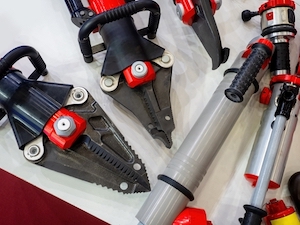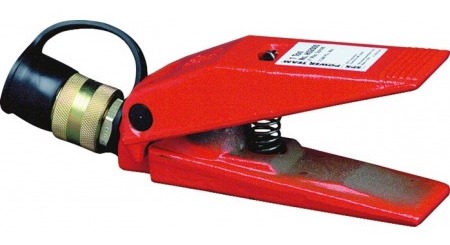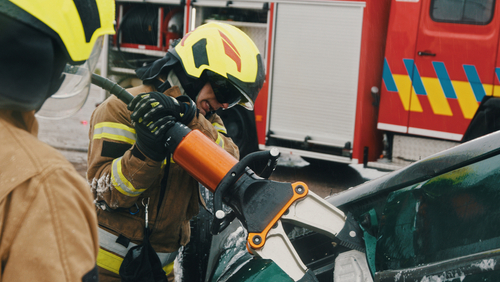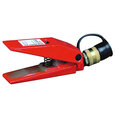Hydraulic Spreader

Figure 1: Hydraulic spreaders used in emergency rescue services.
Hydraulic spreaders are essential for bending a vehicle's metal body or lifting heavy machinery. Hydraulic spreaders use the force-multiplying power of hydraulics to accomplish these tasks. Which hydraulic spreader to use depends on the application: some jobs require more power than others. This article closely examines the working principles of hydraulic spreaders and their varying designs.
Table of contents
- What are hydraulic tools?
- What is a hydraulic spreader tool?
- Hydraulic spreader operation principle
- Types of hydraulic spreaders
- How to use a hydraulic spreader
- Hydraulic spreader applications
- FAQs
View our online selection of hydraulic spreaders!
What are hydraulic tools?
The term hydraulic tool covers many tools that use hydraulic fluid to generate a high amount of force. Examples of hydraulic tools are car jacks, spreaders, torque wrenches, benders, and breakers.
Hydraulics uses an incompressible pressurized fluid to multiply force. When a piston applies pressure to any part of the fluid, the force equally distributes throughout the entire fluid. If this force is transmitted from one area to a larger area, the force multiplies. Pascal first described this phenomenon with Pascal's Law, which states that pressure equals the quotient of force and area. In other words, with constant pressure, as area increases, so does force.
What is a hydraulic spreader tool?
As seen in Figure 1, a hydraulic spreader is a tool with two arms that meet at a narrow point. This design allows the front of the hydraulic spreader to fit in narrow spaces. Industry and rescue services use hydraulic spreaders to lift or push heavy loads. For example, a hydraulic spreader works for pipe and flange repair or to pull apart sections of a vehicle to gain access to anyone trapped inside. Hydraulic spreaders typically generate enough force to lift loads of multiple tons. The exact amount of force that a spreader generates varies depending on the specific hydraulic spreader. Check the spreader's datasheet before purchasing.
Hydraulic spreader operation principle
There are two operation setups for hydraulic spreaders.
- Connecting hoses to the spreader: There are two hoses: a hose to send the hydraulic fluid into the spreader and a return hose. A motorized or air pump pushes hydraulic fluid into the spreader, which moves a piston forward and opens the arms of the tool, as seen in Figure 2. To close the arms of the hydraulic spreader, the operator opens the spreader's control valve, which moves the hydraulic fluid back towards the pump.
- Using a lever: The second type of hydraulic spreader has a lever directly mounted onto the tool's body. This spreader already has hydraulic fluid within it. Operating the lever converts the fluid between high and low pressure. As per Pascal's Law, when the pressure increases, so does the force. The increased force opens the arms of the spreader. Turning a control valve on the spreader depressurizes the hydraulic fluid, which closes the spreader.

Figure 2: A hydraulic spreader in the open position.
Types of hydraulic spreaders
So far, this article has focused on simple hydraulic spreaders. Two other hydraulic tools that operate similarly are the hydraulic ram and the hydraulic multi-tool.
- Hydraulic ram: Hydraulic rams also spread material apart but can spread much further than hydraulic spreaders. Hydraulic rams are long cylinders with a thinner metal cylinder within. Operation of the ram pushes out the metal cylinder to spread material apart. An example use of this tool is to push a dashboard off of a car crash victim. The spreader fits between the car's floor and the dash, then operates to lift the dashboard off of the victim to free them.
- Hydraulic multi-tool: A hydraulic multi-tool combines a hydraulic spreader and a hydraulic cutter. The inside of the spreading arms narrows to a fine edge for cutting. Hydraulic cutters operate similarly to spreaders but cut through material rather than spreading it apart. Hydraulic rescue spreaders are typical for emergency rescue services. The emergency responder must sometimes manipulate metal bars within a vehicle's frame to free a crash victim. These tools also work well on construction sites to cut bolts and rebar.
How to use a hydraulic spreader
Precisely how to use a hydraulic spreader depends on the specific type of spreader and the application. This section will examine how to use hose-connection hydraulic spreaders, spreaders with integrated handles, and spreaders for emergency rescue services.
Following proper safety procedures is paramount regardless of which tool does the job.
- Wear the proper personal protective equipment (PPE). For hydraulic spreaders, PPE is safety goggles at minimum. Gloves and a jumpsuit are also a good choice in case part of the spread material breaks off.
- Ensure any onlookers are at least 5 meters away from the work site. Parts of the spread material can break off and fly in any direction.
- Never operate the pump with the pressure release valve closed and disconnected from the application (i.e., the hydraulic spreader). This action will pressurize the hoses and connections, increasing the chance of bursting.
- Using the hydraulic spreader to lift an object, use proper cribbing techniques. This means inserting a block to maintain the lift after lifting the object to the desired height. Do not use the hydraulic spreader to maintain the lift throughout the job.
- When opening the pressure release valve to depressurize the hydraulic fluid and close the spreader, turn the valve slowly, one half-turn at a time.
- After each use, inspect the components, especially the arms of the hydraulic spreader, for damage. Inspect the hoses and connections for leaks.
Hydraulic spreader with hose connections
Follow these steps to operate a hydraulic spreader with hose connections:
- Connect the hoses to the pump and spreader.
- Vent the hydraulic spreader by opening and closing the arms without a load.
- Place the end of the spreader’s arms into the space that requires spreading. The exact clearance necessary depends on the specific spreader.
- Operate the pump to open the spreader to the desired amount.
- Insert a cribbing block to maintain the spread.
- Open the spreader’s pressure control valve to close the arms and remove the spreader from the work site.
- Complete the necessary work that requires the spreading in the first place.
- Insert the hydraulic spreader and operate it again to take pressure off the cribbing block and remove the block.
- Slowly reverse the spread or lift by following step 6.
Hydraulic spreader with integrated hand pump
The operation of a hydraulic spreader with an integrated hand pump is the same as a hydraulic spreader with hose connections. Follow the steps in the above section to operate a hydraulic spreader with an integrated hand pump. The only difference is that the hand pump pressurizes the hydraulic fluid rather than a motorized or air pump.
Hydraulic spreaders with integrated hand pumps do not require electricity or hose connections. Typically, these tools are light enough to carry long distances. This fact makes these spreaders ideal for remote work sites or sites without electricity.
Hydraulic spreader for emergency rescue services

Figure 3: Emergency rescue responders using a hydraulic spreader on a vehicle.
In most cases, a hydraulic spreader for emergency rescue services will be a hydraulic multi-tool capable of spreading and cutting. The most famous hydraulic spreader for rescue services is the Jaws of Life. In fact, Jaws of Life is a brand name for this type of tool. Many companies manufacture similar spreaders.
Hydraulic spreaders for rescue services should be portable but may still have hose connections for using hydraulic fluid to operate the tool. Without hose connections, the hydraulic spreader has a battery that supplies power to the integrated motor. The motor controls the pressurization and depressurization of the hydraulic fluid. The fluid within the battery-powered hydraulic spreader is a synthetic phosphate-ester fluid that is non-flammable.
Hydraulic spreaders for rescue services spread material in the same way that the hydraulic spreaders discussed above do. However, these spreaders are more prone to slipping because there is often little time or ability to secure the spreader on the material. The slippage can be counteracted by repositioning the back of the hydraulic spreader. Angle the back of the spreader towards the arm that is slipping.
Hydraulic spreader applications
Industry and emergency rescue services use hydraulic spreaders the most. The following are some common applications for hydraulic spreaders.
- Flange facing: Flange facing is the resurfacing of flange faces for maintenance purposes. Hydraulic flange spreaders are applicable for large flanges that do not move easily. Two hydraulic spreaders are necessary on opposite ends of the flanges to ensure uniform spreading.
- Emergency rescue services: Hydraulic multi-tools can bend, cut, and spread a vehicle’s body to allow entrance to the vehicle and rescue of the crash victim.
- Machine lifting: Hydraulic spreaders can lift a heavy machine to level it or access its bottom.
- Rock breaking: A rock can be effectively broken up using one or more hydraulic spreaders, depending on the size of the rock.
FAQs
Do firefighters use hydraulic spreaders?
Yes, firefighters use hydraulic spreaders, typically referred to as Jaws of Life, to gain access to a crashed vehicle and rescue a trapped victim.
How does a hydraulic spreader work?
A hydraulic spreader uses hydraulics to generate a large amount of force necessary to lift heavy machines or bend strong metals.





